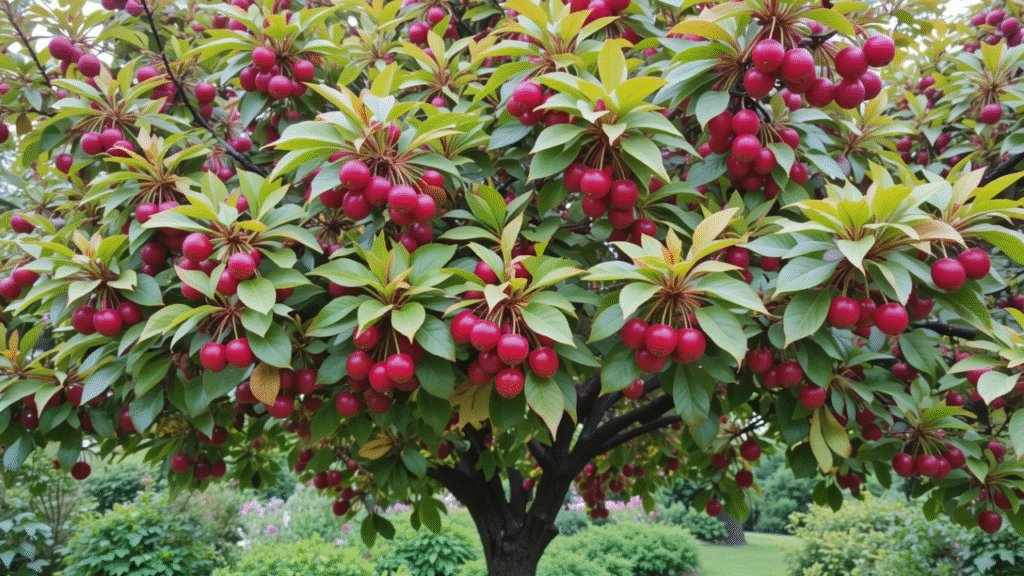
How to Treat Cherry Tree Browning Tips Effectively: Causes, Solutions & Prevention
🍒 Noticed your cherry tree’s leaves turning brown at the tips? Don’t panic—you’re not alone! Browning leaf tips are a common concern for cherry tree growers, and the good news is: most causes are treatable when caught early. Whether you’re growing cherries for their juicy fruit or ornamental beauty, keeping your tree healthy is key to its long-term success. In this guide, we’ll explore how to treat cherry tree browning tips effectively, diving into the root causes, simple solutions, and preventative steps to help your tree thrive again—lush, green, and full of life. 🌿
Table of Contents
Toggle🍂🍒 Understanding Cherry Tree Browning Tips 🍒🍂
If your cherry tree’s leaf tips are turning brown, it’s a clear signal something isn’t right 😟. While it might seem like a minor issue at first, browning tips often point to stress or imbalance—and catching it early can make all the difference in keeping your tree thriving 🌱.

🌿 🍂 What Do Browning Tips Look Like? 🍂
Typically, the edges of the leaves begin to dry out and turn brown. Over time, you may also notice curling, yellowing, or even premature leaf drop. The damage usually starts subtly but can spread quickly if the root cause isn’t addressed.
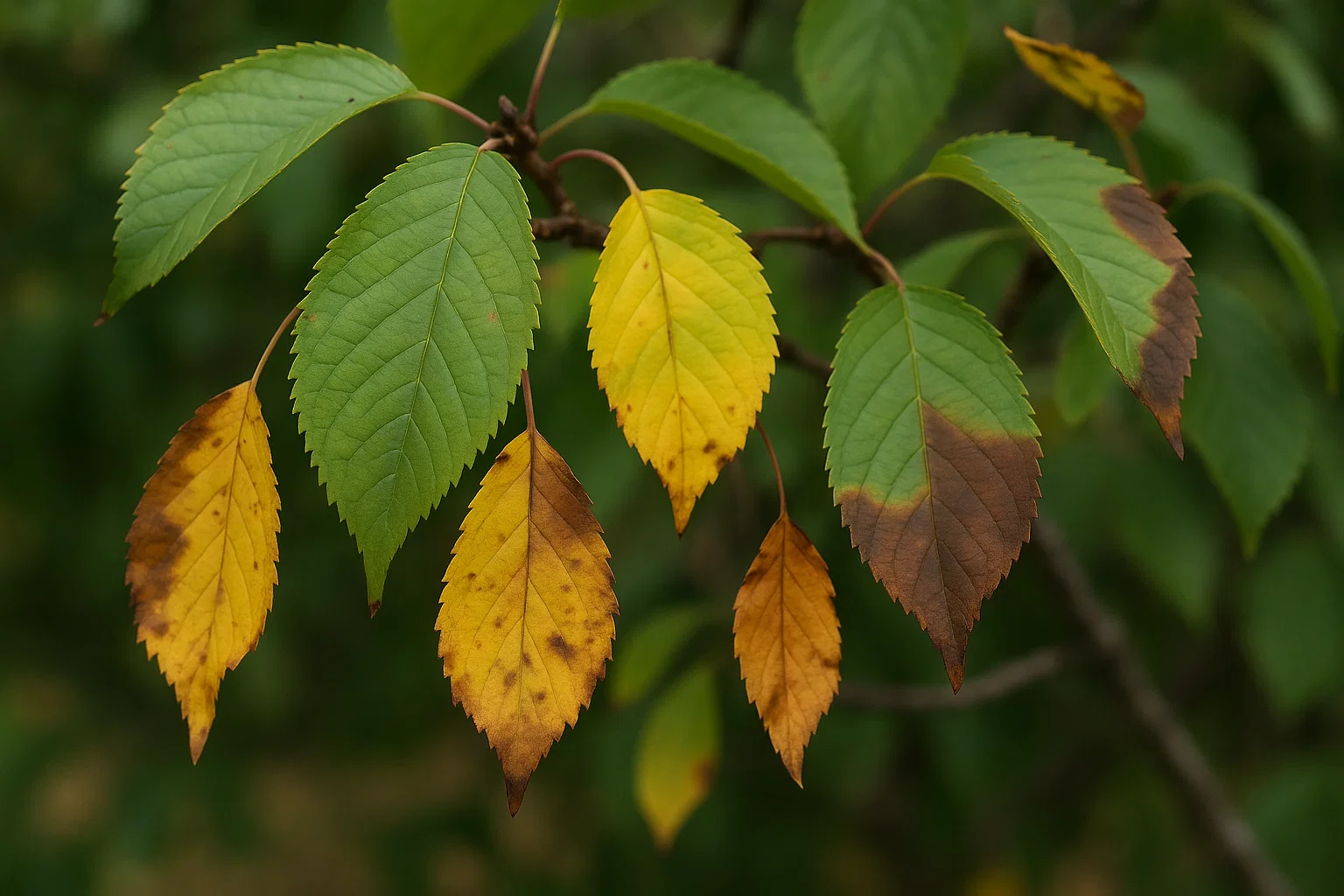
❗🍒 Why It Matters 🍒
Browning tips aren’t just a cosmetic problem—they’re a sign your cherry tree is struggling. This could be due to water stress, nutrient deficiencies, pests, diseases, or even environmental factors like wind or heat 🌞💨. Left untreated, it can weaken the tree, reduce fruit quality, and make it more vulnerable to bigger problems.
Understanding this early warning sign is the first step toward taking action. With the right care and attention, you can bring your cherry tree back to full health—lush, green, and ready to bloom. For best results, be sure to follow expert advice on how to treat cherry tree browning tips effectively to prevent further damage and encourage recovery 🍒🌸.
🌿🍂 Common Causes of Browning Tips 🍂🌿
Browning tips on your cherry tree can be caused by several factors. Identifying the right cause is key to choosing the correct solution. Let’s break down the most common culprits:
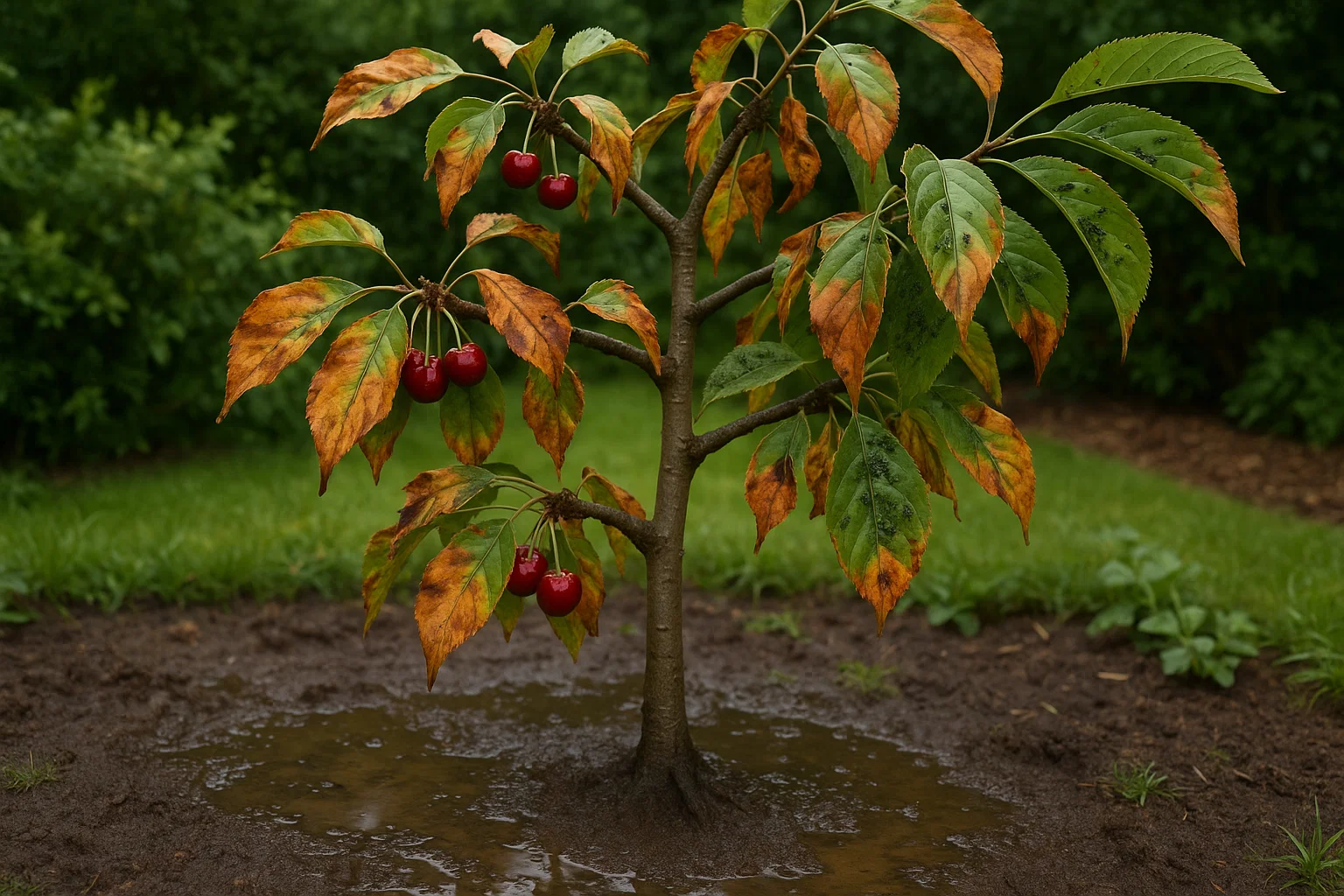
💧 Watering Issues 💧
Watering is one of the biggest factors. Both overwatering and underwatering can lead to browning tips:
- Overwatering: Can cause root rot and poor oxygen flow, leading to brown edges.
- Underwatering: Causes dehydration, making leaves dry and crispy.
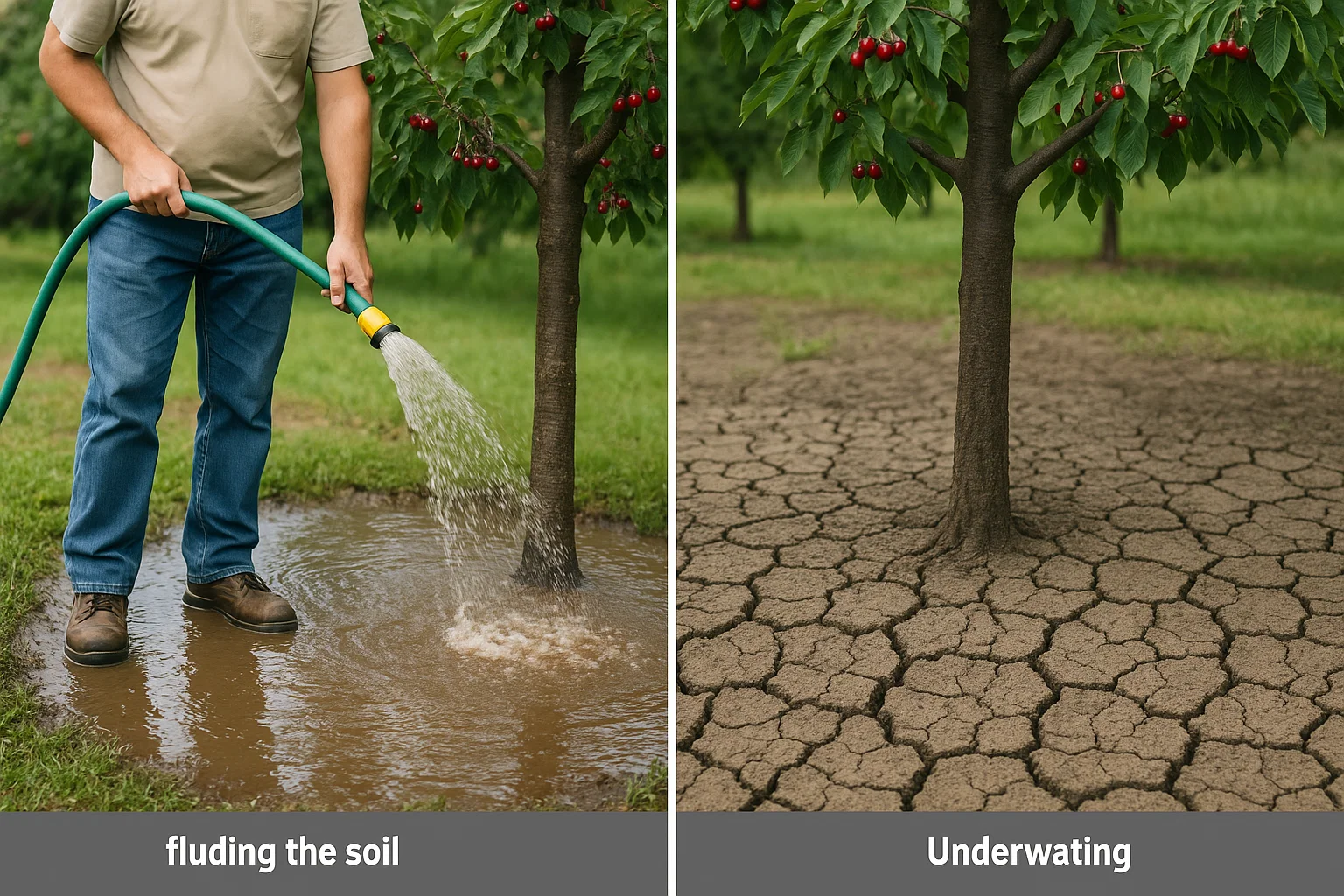
Tip: Always check the soil moisture before watering. Deep watering is better than frequent shallow watering.
🥬 Nutrient Deficiencies 🥬
Cherry trees need balanced nutrients to stay healthy. Deficiencies in key nutrients can cause browning tips:
- Potassium Deficiency: Brown edges, especially in older leaves.
- Magnesium or Iron Deficiency: Can cause yellowing or browning at the tips.

Tip: Test your soil and fertilize with a balanced mix designed for fruit trees to restore nutrients.
🌬️☀️ Environmental Stress 🌬️☀️
Cherry trees are sensitive to extreme weather conditions:
- Heat and Sunburn: Intense sun can scorch the leaves, causing them to turn brown at the edges.
- Cold or Frost Damage: Sudden cold snaps or frost in early spring can cause browning on new growth.
Tip: Provide shade during the hottest part of the day and protect the tree from late frosts.
🌱 Soil Problems 🌱
Poor soil quality can affect your tree’s health:
- pH Imbalance: Too much acid or alkaline soil can prevent proper nutrient absorption.
- Compacted Soil: Limits root growth and water drainage, leading to stress.
Tip: Test the soil pH and amend it with lime or sulfur as needed. Aerate the soil regularly for healthy roots.
🐛🦠 Pests and Diseases 🐛🦠
Insects and fungal infections can cause serious damage:
- Pests: Aphids, spider mites, and scale insects can suck sap from leaves, causing browning.
- Diseases: Fungal infections like leaf spot or bacterial canker can cause tissue damage, leading to brown tips.
Tip: Keep an eye out for pests and treat them with natural insecticides or pruning affected areas. For diseases, remove and dispose of infected leaves.
⚠️ Chemical Damage ⚠️
Overuse of fertilizers or herbicides can cause burns:
- Fertilizer Burn: Too much fertilizer can damage the roots, leading to browning at the tips.
- Herbicide Drift: Chemicals from nearby treatments can damage cherry trees.
Tip: Always follow fertilizer instructions and avoid spraying chemicals near your tree.
By recognizing these causes early, you can take steps to treat and prevent further damage. In the next section, we’ll discuss how to treat these issues effectively. Understanding how to treat cherry tree browning tips effectively will give you the tools to restore your tree’s health and vitality. 🌿🍒
🌱✨ How to Treat Browning Tips Effectively ✨🌱
Now that we’ve identified the common causes of browning tips, let’s dive into how to treat cherry tree browning tips effectively. Addressing the root cause will help your tree bounce back stronger and healthier.
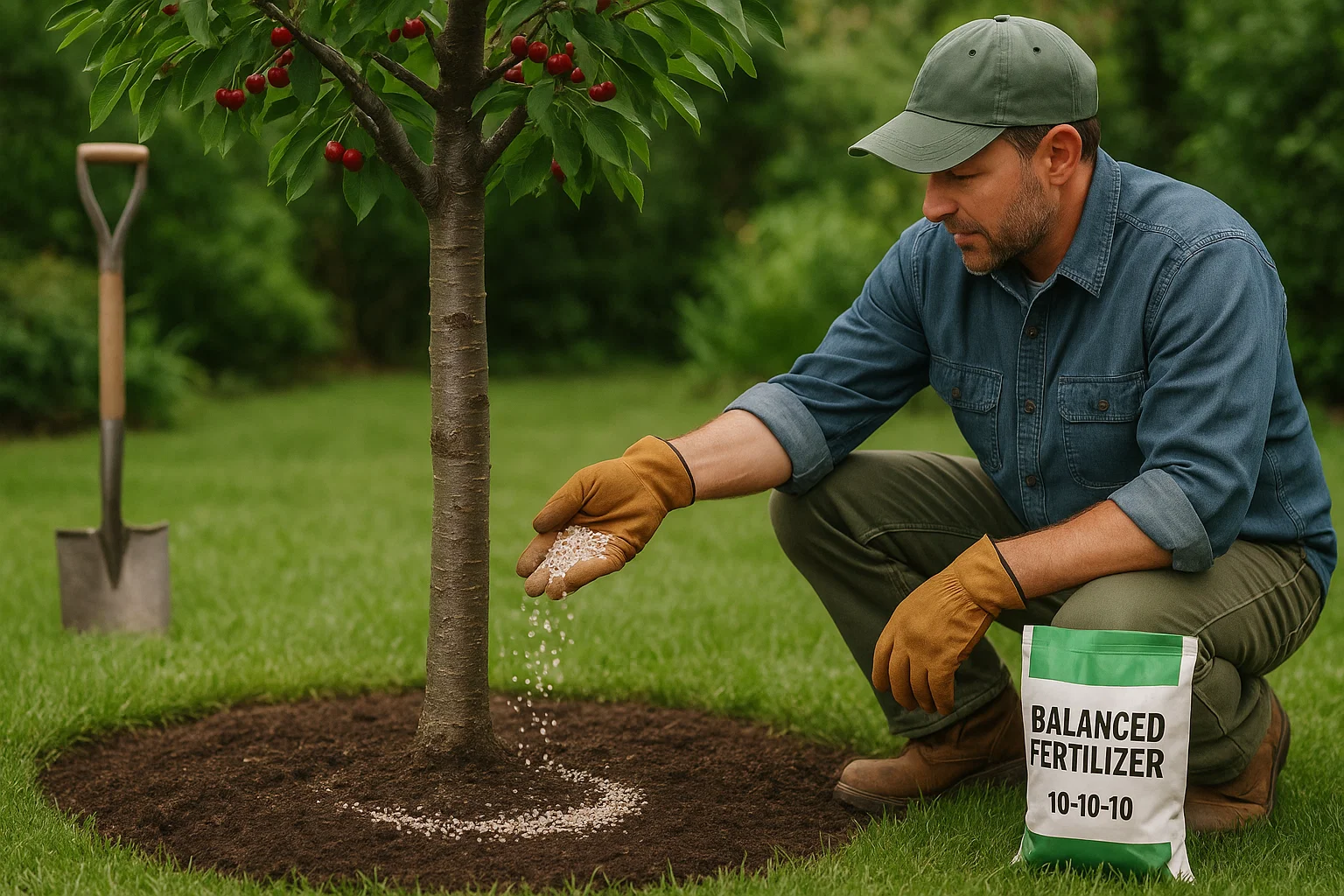
💧 Adjust Watering Practices 💧
Overwatering or underwatering can easily stress your tree, causing browning. Here’s how to fix it:
- For Overwatering: Ensure your tree has well-draining soil. Reduce watering frequency, and consider adding mulch to help retain moisture without saturating the soil.
- For Underwatering: Water deeply but infrequently, ensuring the water reaches the root zone. Always check soil moisture before watering to avoid drought stress.
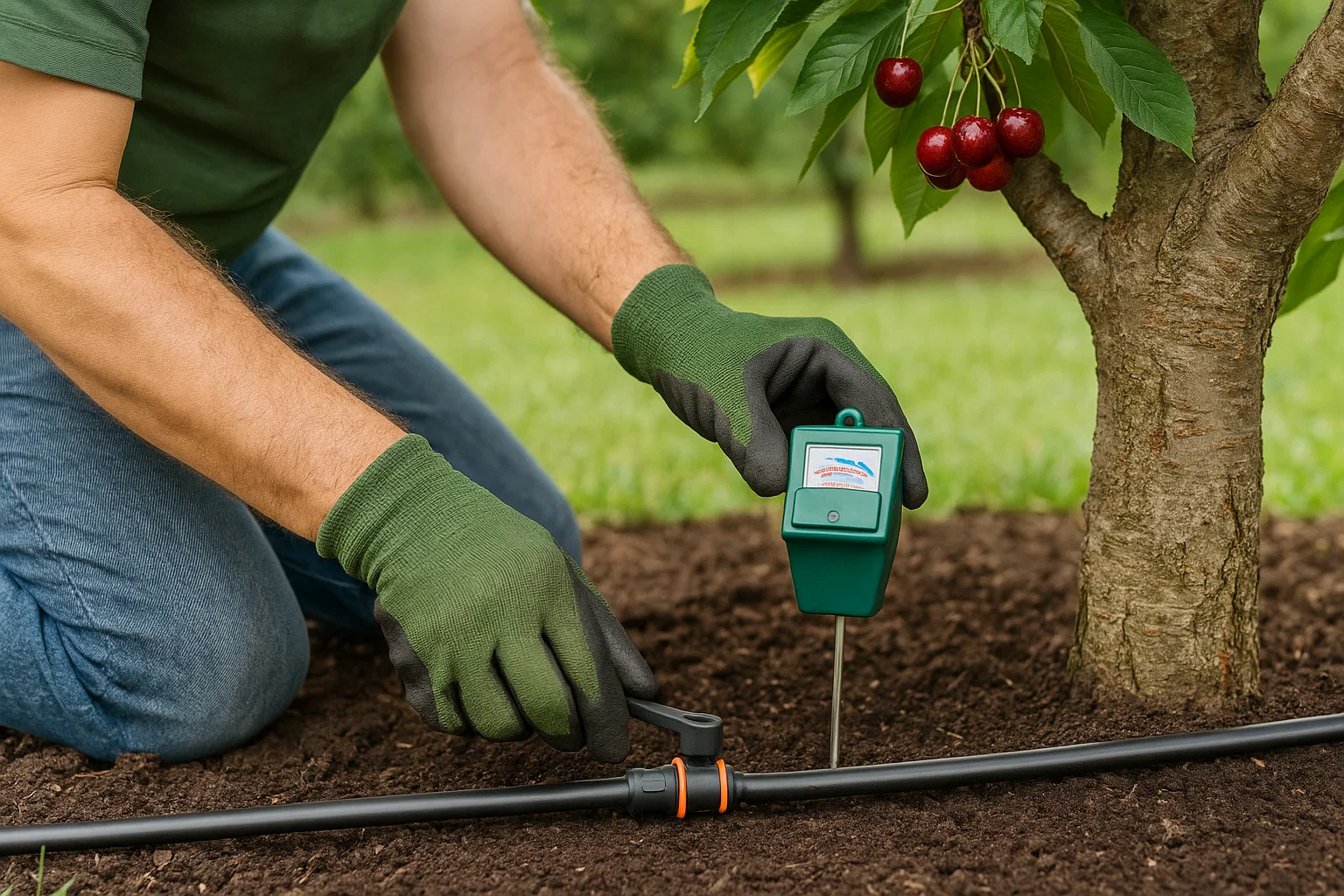
Tip: Use a moisture meter to monitor the soil. The top 2 inches should be dry before watering again.
🌿 Fertilize Correctly 🌿
A nutrient imbalance can contribute to browning tips. To correct it:
- For Potassium Deficiency: Use a balanced fertilizer with a higher potassium content (e.g., 10-5-10). Potassium promotes strong, healthy leaves.
- For Magnesium or Iron Deficiency: Apply a foliar spray with magnesium sulfate (Epsom salts) or an iron chelate solution to correct deficiencies quickly.
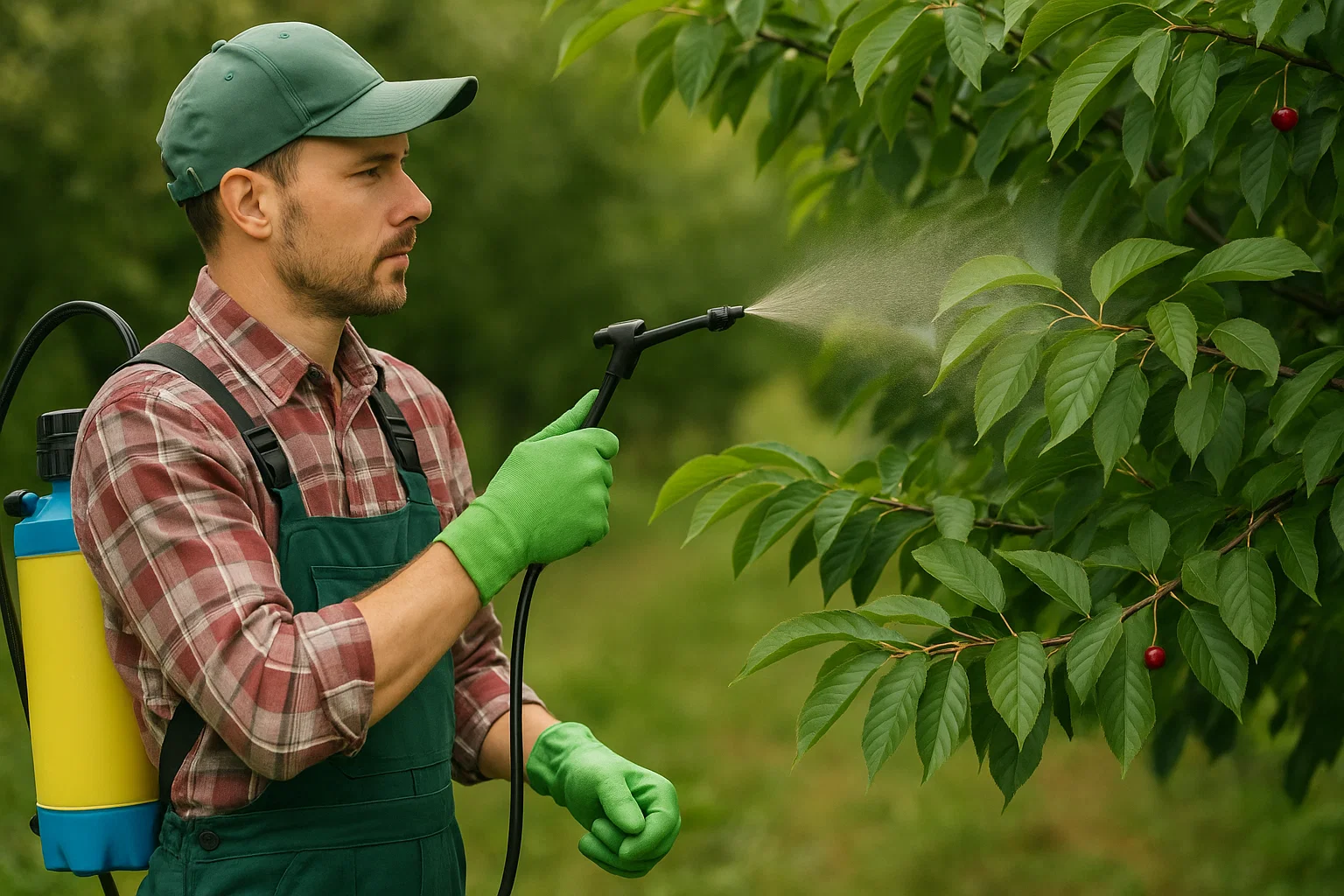
Tip: Test your soil before fertilizing to ensure you’re addressing the right nutrient gap.
🌍 Improve Soil Quality 🌍
Soil problems, like pH imbalance or compacted soil, need attention:
- To Adjust pH: If the soil is too acidic, add lime; if too alkaline, use sulfur to lower the pH.
- To Improve Drainage: Aerate the soil around the tree’s root zone and add organic matter like compost or well-rotted manure.
Tip: Regularly mulch around the base of your tree to maintain consistent soil temperature and moisture.
🌞❄️ Manage Environmental Stress 🌞❄️
Environmental factors like heat, frost, and wind can stress your tree, causing browning tips. Here’s how to reduce stress:
- Provide Shade: Use shade cloth or plant nearby shrubs to protect your tree from scorching heat.
- Frost Protection: If frost is expected, cover the tree with frost cloths or blankets during the coldest nights.
- Wind Protection: Consider adding a windbreak if your cherry tree is exposed to strong winds.
Tip: Be proactive in protecting your tree during extreme weather, especially in spring or fall when temperatures fluctuate.
🐞🦠 Treat Pests and Diseases 🐞🦠
Pests and diseases can cause serious damage to your tree’s health. Here’s how to handle them:
- For Pests: Use insecticidal soap or neem oil to treat aphids, spider mites, and other common pests. Always target the undersides of leaves where pests like to hide.
- For Diseases: Remove and dispose of infected leaves. For fungal infections, apply a fungicide and ensure proper air circulation around the tree.
Tip: Regularly inspect your tree for signs of pests or diseases to catch problems early before they spread.
⚠️ Avoid Chemical Damage ⚠️
To prevent chemical damage, follow these steps:
- For Fertilizer Burn: If you suspect over-fertilizing, flush the soil with water to remove excess nutrients and let the tree recover.
- For Herbicide Drift: Avoid spraying herbicides near your cherry tree, and ensure any treatments are applied with care to prevent damage.
Tip: Always follow manufacturer instructions for fertilizers and herbicides to prevent accidental damage to your tree.
By addressing these issues with the right care and attention, your cherry tree can recover from browning tips and thrive again. In the next section, we’ll explore prevention tips to keep your tree healthy all year round! 🌳✨
🌳💚 Preventative Tips for Healthy Cherry Trees 💚🌳
Preventing cherry tree browning tips starts with proactive care. By following these simple steps, you can ensure your tree stays healthy and strong year-round, reducing the risk of browning tips and other issues.

💧 Regular Watering Routine 💧
Consistent watering is key to keeping your tree hydrated without overdoing it:
- Deep Watering: Water your tree deeply but infrequently, ensuring the moisture reaches the roots. This encourages strong root growth.
- Check Soil Moisture: Use a moisture meter or stick your finger 2 inches into the soil to see if it’s dry. Only water when needed.
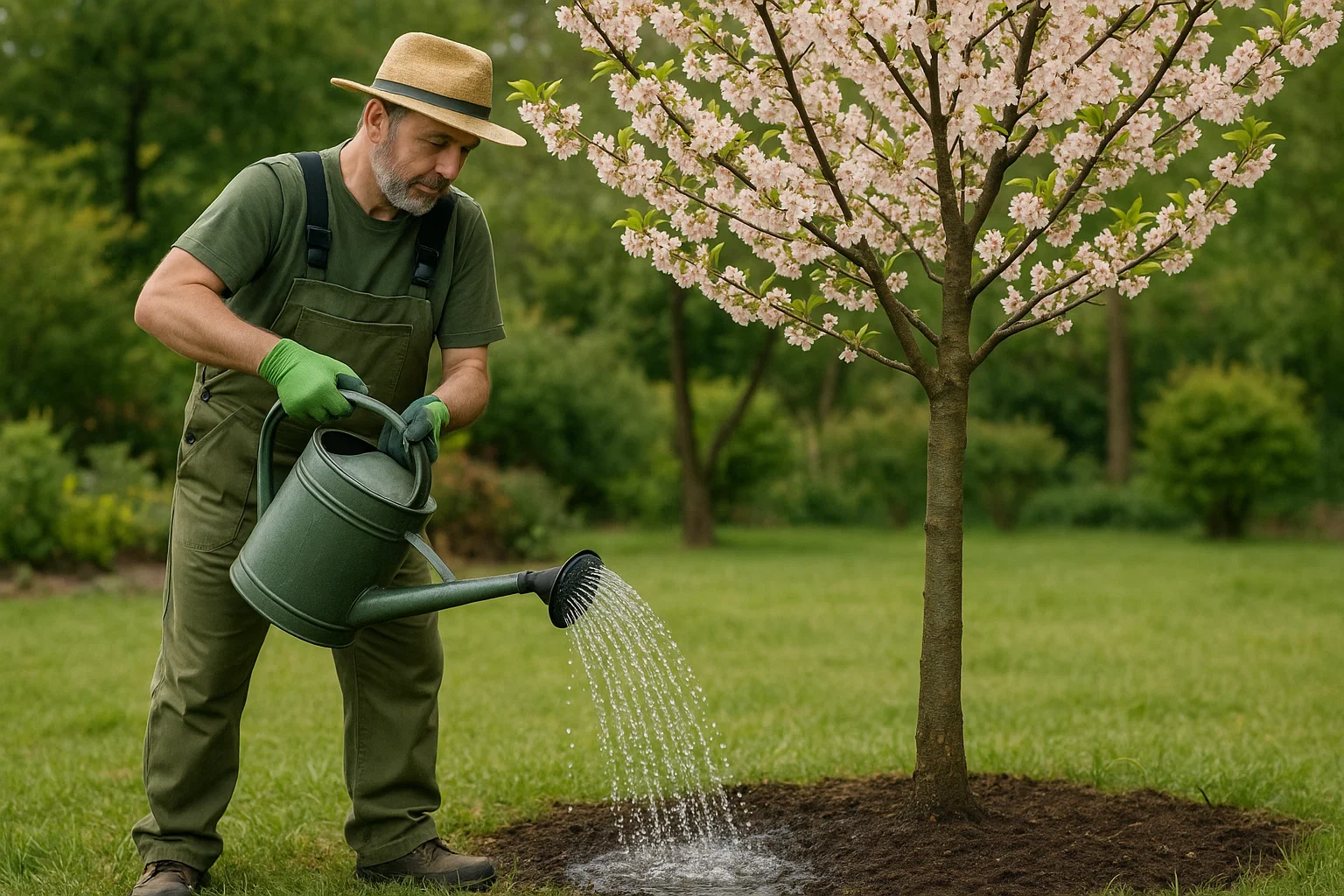
Tip: Water in the early morning to reduce evaporation and fungal risks.
🧪 Annual Soil Testing 🧪
Soil health is the foundation of a healthy cherry tree:
- Test Soil pH: Cherry trees prefer slightly acidic soil (pH 6.0–6.5). Testing your soil annually helps you adjust pH levels and ensure nutrient availability.
- Add Organic Matter: Use compost, mulch, or well-rotted manure to keep soil rich in nutrients and improve drainage.
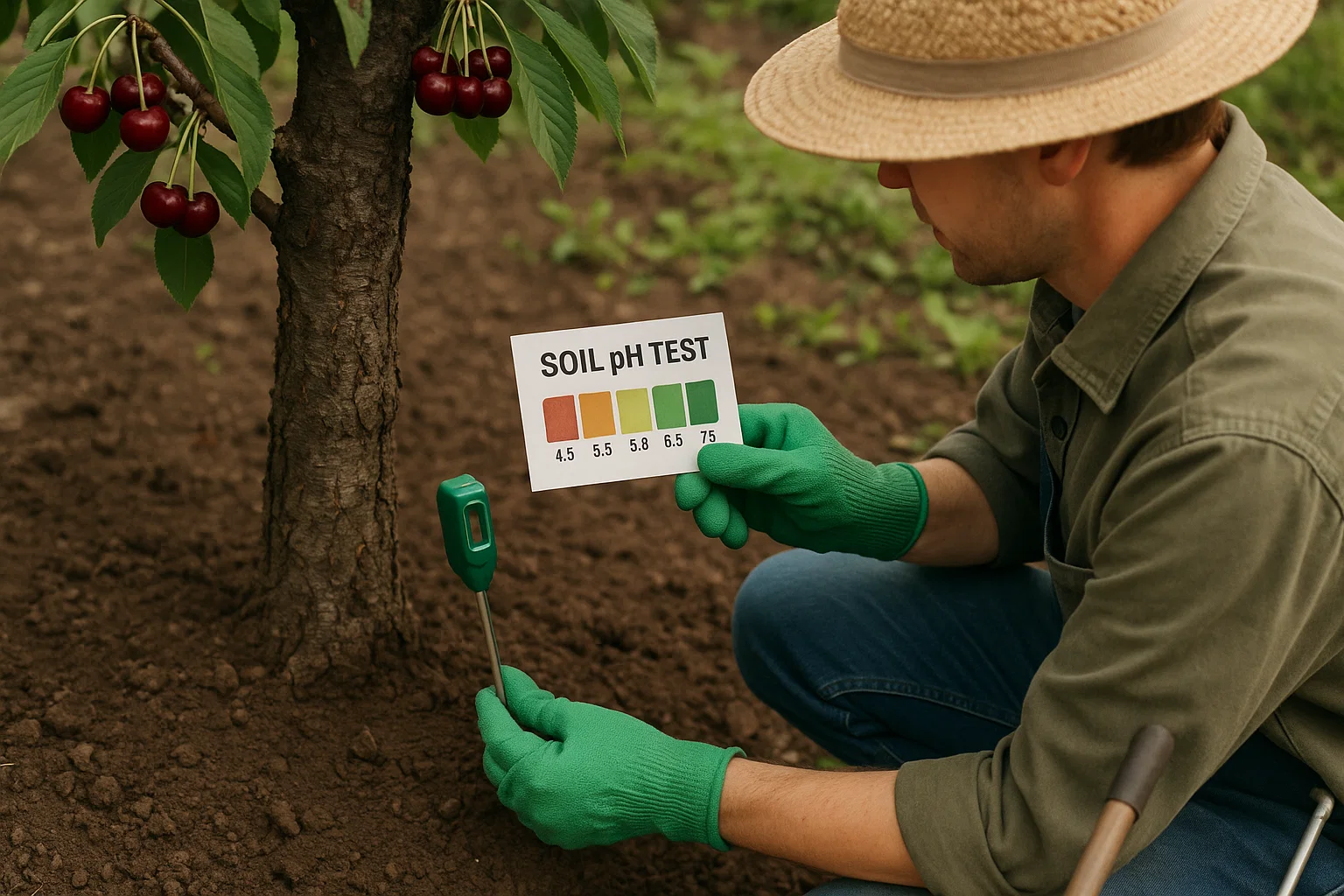
Tip: Healthy soil means healthier trees, so consider adding compost or organic matter at least once a year.
✂️ Pruning for Airflow ✂️
Proper pruning helps prevent overcrowded branches and improves air circulation around your tree:
- Remove Dead or Diseased Branches: Prune away any dead, diseased, or crossing branches to reduce pest and disease risks.
- Open Up the Canopy: Thin out the inner branches to allow more light and air to reach the center of the tree.
Tip: Prune your tree in late winter or early spring before new growth starts for the best results.
🐜🦋 Protect from Pests 🐜🦋
Prevention is key when it comes to pests:
- Monitor Regularly: Inspect your tree regularly for signs of pests like aphids, spider mites, or scale insects.
- Use Organic Treatments: Neem oil or insecticidal soap can help keep pests at bay without harming the tree.
Tip: Consider placing sticky traps around your tree to catch flying pests early on.
🌱 Mulching for Moisture & Temperature Control 🌱
A layer of mulch is your cherry tree’s best friend:
- Apply Mulch Around the Base: Spread a 2-3 inch layer of organic mulch (like wood chips or straw) around the base of the tree to retain moisture and regulate temperature.
- Keep Mulch Away from the Trunk: Make sure mulch is not piled up directly against the trunk to prevent rot.
Tip: Mulch not only conserves moisture but also adds essential nutrients as it decomposes.
🌨️ Seasonal Protection 🌨️
Protect your tree from extreme weather and stress:
- Shade During Heatwaves: Use shade cloth or plant nearby shrubs to shield your tree from excessive sun during hot weather.
- Cover During Frost: If a late frost threatens your tree, use frost cloths or blankets to protect the new growth.
Tip: Be mindful of weather forecasts and act quickly when protecting your tree from extreme conditions.
By following these preventative tips, you’ll set your cherry tree up for long-term health and vitality. Taking small, proactive steps now can prevent issues like browning tips, ensuring your tree remains lush, green, and productive for years to come! 🌳🍒
⚠️🌿 When to Worry: Signs It’s More Serious 🌿⚠️
While browning tips can often be fixed with simple treatments, there are times when they signal something more serious. It’s important to know when to take immediate action and when to consult an expert.

😨 Rapid Spreading of Browning 😨
If the brown tips start spreading quickly across the entire tree, affecting many leaves or entire branches, it could be a sign of a more severe problem. This may indicate:
- Root Rot: Caused by overwatering or poor drainage, root rot can spread from the roots to the rest of the tree, leading to rapid deterioration.
- Systemic Disease: Some diseases affect the entire tree and can cause widespread browning, especially if they’re fungal or bacterial in nature.
When to worry: If you notice fast-moving damage or see no improvement after treating the tree, it’s time to take action.
🍂 Significant Leaf Drop 🍂
While occasional leaf drop is normal, a sudden or excessive loss of leaves (especially with browning tips) can indicate serious stress. This could be a result of:
- Nutrient Imbalance: Severe deficiencies in essential nutrients like nitrogen or potassium can cause widespread leaf damage.
- Pests or Diseases: Infestations or infections can weaken the tree, causing it to drop leaves prematurely.
When to worry: If large branches are shedding leaves at an alarming rate, seek professional advice.
🌑 Blackened or Softening Bark 🌑
If you notice that the bark near the browning tips becomes blackened, soft, or mushy, this is a clear sign of bacterial canker or other infections. This condition can lead to dieback, where branches or entire sections of the tree begin to wither and die.
When to worry: Blackened bark or mushy areas should not be ignored. These signs usually require specialized treatment or pruning.
🌱 Lack of New Growth 🌱
A healthy cherry tree should produce new growth every spring. If you notice that the tree is not producing new shoots or leaves, even after following proper care routines, it could point to:
- Severe Root Damage: Compacted soil, overwatering, or root disease can prevent the tree from establishing healthy roots, leading to poor growth.
- Chronic Stress: Long-term environmental stress or pest problems can cause the tree to stop growing altogether.
When to worry: If there’s little to no new growth in the spring, it’s time to assess the roots and overall health of the tree more closely.
🦠 Foul Odor or Slime 🦠
A foul smell around the base of your tree or a sticky, slimy residue on the leaves is a warning sign of severe infection. Bacterial or fungal diseases like bacterial canker or phytophthora root rot can cause such symptoms, often leading to tree decline if left untreated.
When to worry: If your tree starts emitting a foul odor or if the leaves are covered in sticky sap, you should act immediately to treat the infection.
What to Do If You Notice Serious Signs:
If you observe any of the serious symptoms mentioned above, it’s important to:
- Consult an Expert: Reach out to a local arborist, tree specialist, or extension service to get a professional diagnosis.
- Prune and Remove Infected Parts: If disease or pest damage is localized, remove the affected branches to prevent further spread.
- Consider Soil and Root Testing: In cases of root rot or nutrient deficiencies, a soil test can help determine the best course of action.
Recognizing these serious signs early can save your cherry tree and help you take immediate steps to restore its health. When in doubt, always seek professional advice to ensure your tree gets the care it needs. 🌳🍒 Knowing how to treat cherry tree browning tips effectively can make all the difference in preventing long-term damage.
🌿🍒 Final Thoughts 🍒🌿
Taking care of your cherry tree and addressing browning tips early can make all the difference in keeping it healthy and productive. By understanding the common causes, treating issues promptly, and following preventative tips, you’ll help your tree flourish year after year. 🌳✨
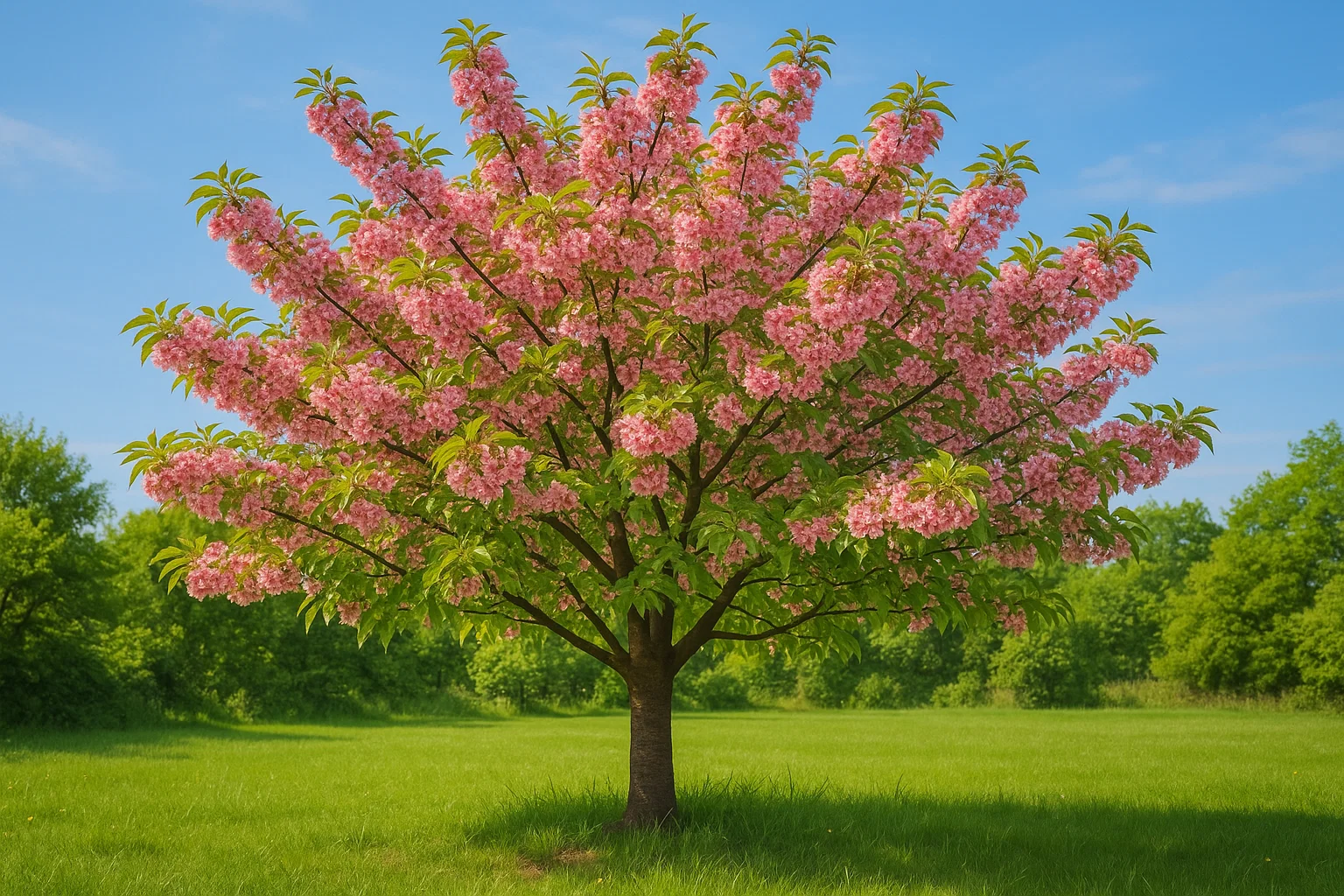
Remember, patience and observation are key. Trees need time to recover, and by being proactive, you can ensure they stay vibrant and strong. Whether it’s adjusting your watering habits, improving soil quality, or protecting against pests, small steps add up to a healthier cherry tree in the long run.
With the right care, your cherry tree will reward you with beautiful foliage, healthy growth, and delicious fruit. So go ahead—take these insights, apply them to your tree, and enjoy watching it thrive! 🍒🌿
Frequently Asked Questions (FAQ)
What causes cherry tree leaf tips to turn brown?
Common causes include water stress, nutrient deficiencies, root damage, pests, or fungal diseases.
Is browning of cherry tree tips a sign of disease?
Yes, it can be. Fungal infections like leaf spot or bacterial blight are often responsible for browning tips.
How can I tell if the browning is due to overwatering or underwatering?
Overwatering usually causes yellowing and soggy soil, while underwatering leads to dry, crispy leaves and soil.
What nutrients help prevent browning leaf tips?
Potassium, magnesium, and adequate nitrogen are essential. A soil test can identify deficiencies.
Should I prune brown leaves from my cherry tree?
Yes, pruning affected areas can improve airflow and reduce the spread of disease.
Can pests cause browning of cherry tree tips?
Absolutely. Aphids, spider mites, or borers can damage leaves and cause tip browning.
What’s the best treatment for fungal leaf browning?
Use a copper-based fungicide or neem oil, and ensure good spacing and air circulation.
How can I prevent browning tips in the future?
Water deeply but less often, mulch properly, fertilize based on soil needs, and monitor for pests regularly.
